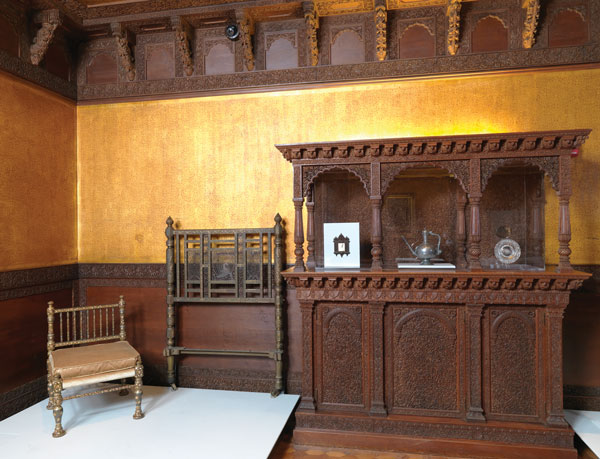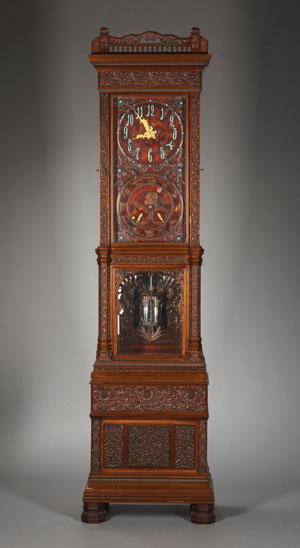A Taste of the Exotic
Writer Leslie Gilbert ElmanLockwood de Forest’s interiors and furnishings brought the exotic east to the Gilded Age.
To become a tastemaker you need an artist’s eye, a flair for the dramatic, a head for business and access to a wealthy, influential client base. Based on those criteria, you could say Lockwood de Forest (1850-1932) was born for the job.
Although better known as a painter, de Forest also was known for bringing Indian and Middle Eastern influences into American home decor of the mid- to late-19th century. At a time when production of household furnishings was moving toward machine-made, he celebrated the handwork of artisans and the influences of cultures outside Europe and America. Incorporating a few choice objects into a traditional room scheme or decorating entire rooms, his eclectic style characterized what art historian Roberta A. Mayer calls “the exuberant exoticism that was part of Gilded Age taste.”
A Passage to India
In 1880, Lockwood de Forest married Meta Kemble, and they took off on what turned out to be a nearly two-year honeymoon to the Asian subcontinent. They chose their unconventional destination largely so de Forest could pursue his business interests—a newly formed partnership with his friend Louis Comfort Tiffany. So, besides sightseeing in India and trekking in Nepal, de Forest studied Indian architecture and decorative arts. Most importantly, he connected with Muggunbhai Hutheesing, whose factory at Ahmedabad in the Indian state of Gujarat would be a key to de Forest’s success.
In 1883, the Times of India said, “Mr. Muggunbhai may correctly be stated to have resuscitated the art of wood carving at Ahmedabad. He employs about 100 workmen, who consist of the best carvers in Ahmedabad and the outlying districts.” Most of those workers were employed on projects for Lockwood de Forest, carving teak furniture and architectural ornamentation for homes and buildings from New York City to San Francisco.
De Forest was “essentially collecting Kashmiri design and putting it into a form he thought would be useful in the West,” says Sarah Coffin, curator of decorative arts at the Cooper Hewitt Museum in New York City. The teak carvings were authentically Indian, but the furniture forms, archways, brackets and other ornaments derive from American or European styles. The unconventional mix yielded a happy hybrid, with the disparate patterns of carvings, printed textiles and Oriental rugs creating a harmonious whole.
Six Degrees of Separation
Lockwood de Forest’s father was a prominent New York attorney with a family fortune from the shipping industry. His mother’s father was the first president of the New York Stock Exchange. His wife was the granddaughter of Alfred V. du Pont.
That pedigree connected him by relation or acquaintance to most of the influencers of his day. Chicago businessmen Charles Tyson Yerkes and Potter Palmer, Mary Garrett (heiress to the Baltimore and Ohio Railroad fortune), Andrew Carnegie, Mark Twain—from the 1880s to the early 1900s, he designed and decorated home interiors for them all.
For the Carnegie home on East 91st Street in Manhattan he designed the family library. That building is now the Cooper Hewitt Museum, and its “Teak Room” remains the most complete example of a de Forest-designed room in its original location.
Mary Garrett recommended him to design the interior of the Deanery at Bryn Mawr College for her friend M.Carey Thomas. In the splendor of her Lockwood de Forest-designed rooms Dean Thomas entertained notable guests—William Butler Yeats, Henry James and Susan B. Anthony among them. Garrett eventually moved into the Deanery with Thomas, bringing with her many of the de Forest furnishings from her Baltimore home. Although the Deanery has since been demolished, some of its fixtures and furnishings have been installed in other locations on the Bryn Mawr campus on the Philadelphia Main Line.
De Forest’s work can be seen also at Olana, the home of Hudson River School painter Frederic E. Church (a relative on his mother’s side) in Hudson, New York, and the Mark Twain House in Hartford, Connecticut. His own home at 7 East 10th Street in Manhattan, which the author Rudyard Kipling described as “one of the very luxurioustest houses I’ve ever seen,” is now owned by New York University.
Although he lived to his 80s and continued working for most of his life, de Forest’s “moment” was relatively brief. By the early 1900s, other home decor fashions supplanted the artistry of the Aesthetic Movement. In 1922, after he moved to Santa Barbara, California, the furnishings from his New York home were sold at auction.
Yet his influence lives on in the way we bring artisan pieces into even the most contemporary home interiors to add character and individuality.
In a 1907 letter to de Forest, M. Carey Thomas wrote, “If it were possible by any system of training for you to create a school of architects and decorators like yourself, I should be only too glad to drop everything else and devote myself to getting money to endow such a school; but it is not possible. Such people are, I believe, born and not made.” In Lockwood de Forest’s case, she was right.
Leslie Gilbert Elman, author of Weird But True: 200 Astounding, Outrageous and Totally Off the Wall Facts, writes about antiques and other subjects for Design NJ.
“Passion for the Exotic: Lockwood de Forest, Frederic Church” is on display at the Cooper Hewitt, Smithsonian Design Museum, in New York City through September 26. cooperhewitt.org. For more on Lockwood de Forest, read Lockwood de Forest: Furnishing the Gilded Age with a Passion for India by Roberta A. Mayer (University of Delaware Press, 2008).



